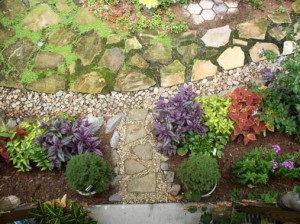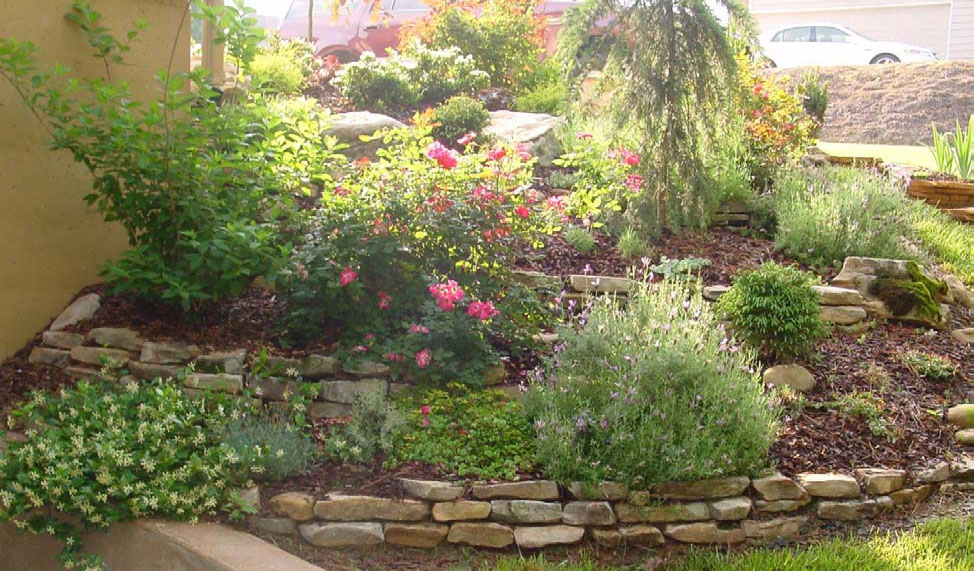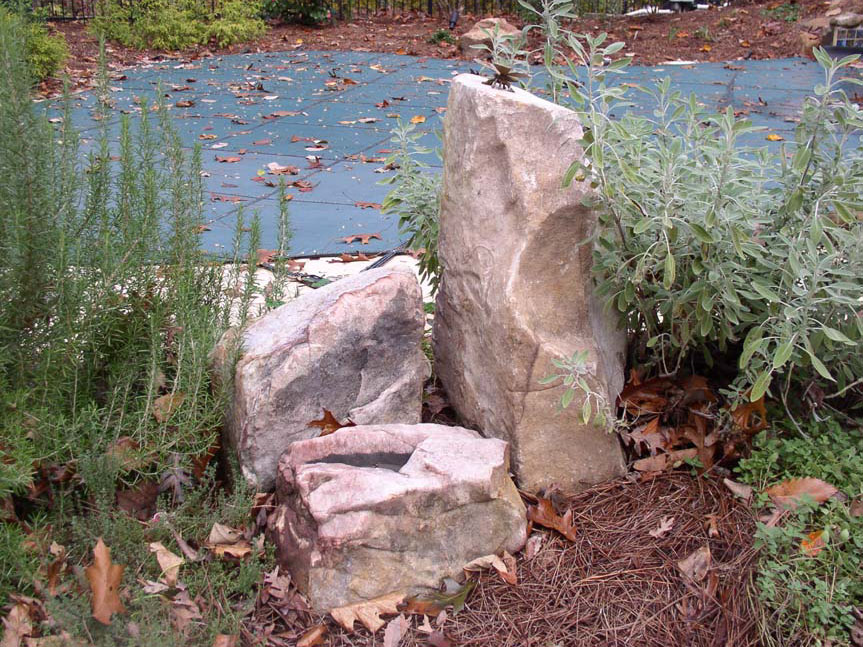Harmony in the garden is created when there’s balance. In Eastern Philosophy it is the gentle balance of Yin and Yang. Yin and Yang are basically two energies. Yin is the dark, passive, grounding, and a cooler energy. Yang is the light, active, and warmer energy. Notice how the most harmonious gardens will contain a balance of stone, plants, architecture (something man-made), and water (though real water can sometimes be ‘mimicked’ successfully). Occasionally this balance is so subtle, soothing, and perfectly natural, that you may not notice… Bravo!! This is a job well done by the garden designer.
When I see the natural and asymmetrical use of stone in the garden, I’m immediately reminded of how Asian gardens have influenced our western gardens. So often in our Western culture, we naturally want to fill up the space with plants, plants, and more plants. Sure, I’ve been guilty of this too…being a plant addict. But we must remind ourselves of the balance and leave room for stone, water, a dash of architecture, and some ‘space’.
The stone adds structure, grounding, coolness, strength, and mystery of the ancient. Plants soften the edges; add life and light, and sometimes movement when the element of wind is introduced. Water brings animation and the dynamics of activity, an affirmation that your garden is alive! The touch of architecture reminds us of our creativity (though it might be very geometric) and connection to the natural world; an art form created by our hands using Mother Nature’s elements.
We can use stone in a variety of ways in our landscape. Not only is it decorative, it’s highly functional. Stone can be used to create walkways, patios, walls, terracing, architecture, water features, or decorative accents for balance. Stone is available in a variety of shapes, colors, and sizes. Let’s first discuss the different types most commonly available in our area and a few terms you will run across:
- Field Stone (typically Tennessee or Pennsylvania) – is an aged sandstone rock that is gray
 to tannish in color. It’s also from the surface, giving it more of an aged and weathered appearance. Its surface is typically more uneven than a flagstone. It can be used for walls, steps, and stack. Thicker fieldstone works well for water features.
to tannish in color. It’s also from the surface, giving it more of an aged and weathered appearance. Its surface is typically more uneven than a flagstone. It can be used for walls, steps, and stack. Thicker fieldstone works well for water features. - Flag stone (bluff rock) – is also a sandstone rock that is quarried from sheets of sedimentary layers of rock. Flagstone, in contrast to fieldstone, is
usually warmer earth tones such as yellow ochre or terra cotta). It has a much smoother surface than fieldstone. It’s often used for dry stacking of barrier walls to sidewalks, pavers, etc. Pavers can be “soft set” (no mortar) or set using mortar. - Stack stone – This can be a field or flagstone. It ranges from thick, medium, to thin (veneer) in thickness. The thin pieces are approximately 1 inch thick, medium 1.5 to 2 inches, and thick is 2 to 3 inches. A stack stonewall can be a dry stack (no mortar) or a mortar stack. Boulders- this includes a variety of shapes, sizes, colors, and patinas. My favorite is mossy basket boulders. These are somewhat rounded, smoother than a fieldstone, with a natural moss patina on them. They work well around natural looking water features and dry creek beds.
 River rock – has rounded edges and surface smoothed by the water. It comes in two shapes “rounds” and “flats”. It’s in a variety of sizes from “egg” size on up to basketball size. It has a variety of uses from dry creek beds, to walls, and step stones (for flatter stones and can be sunk into the ground).
River rock – has rounded edges and surface smoothed by the water. It comes in two shapes “rounds” and “flats”. It’s in a variety of sizes from “egg” size on up to basketball size. It has a variety of uses from dry creek beds, to walls, and step stones (for flatter stones and can be sunk into the ground).- Cobbles, rubble, and “brick”- are used for stack walls, paths, borders and typically uniform in shape and size making it easy for installation. The bricks are typically long narrow pieces made from flagstone (used as borders, edging, step risers, walls).
- Aggregates (gravel) and sand – this would include the smaller stones and chips such as pea gravel, marble chips, granite chips, slate chips, Alabama rose stone which can be used in walkways or between pavers. This also includes crushed granite sand, which is typically used for dry laid (soft set) stone.
- Natural shape vs. rectangular (geometric) cut- more often you will find flag stone in a natural irregular shape. However, it can also be purchased in precut rectangular shapes, which works well when laying a patio that is of a rectangular shape. Precut also works well when laying steps or stair treads that are of a consistent size and more formal in appearance.
- Tumbled- typically cobbles (sometimes flagstone) are tumbled in a machine to smooth the edges.
Because it takes years to become a skilled stone mason and a well trained eye to place stone in the landscape, you may want to consult with a professional first and take careful notes as they install your project for you. Or perhaps you can take on a smaller project such as a small terrace, a small soft-set patio, or a small water feature. If you are a Do-It-Yourselfer, here are some general guidelines to follow when using stone in your landscape:
- When building stack stone terraces, angle the wall slightly so it leans towards the slope you’re terracing. And always be sure to have proper drainage installed at the base of the wall/terrace (you will probably want to consult with a landscape architect and a stone mason when building large walls, terraces, and other structures).
- Using fewer but larger rocks in a water feature and as decorative accents is much more appealing and natural looking than a lot of little stones.
- Boulders typically look bigger at the stone yard…so pre measure the space at home to be sure of the size at the time of purchase.
- When setting large boulders, partially submerse the stone into the earth. They are best when laid into a slope. Don’t lay them on top of the ground as if it fell off of the truck.
- Typically groupings of 1 or 3 boulders look best. In Japanese gardens, a grouping of 3 boulders represents the Buddha stone (Mida buhtsu- the male stone), the Goddess stone (Kwannon- the female stone), Child’s stone (Seishi). These 3 stones are of 3 different heights. The first, tallest, being a vertical looking stone and the others being progressively smaller and horizontal.
- Since stone is available in so many colors, be sure it blends with the colors and materials of your home.
- Avoid laying large boulders at a 90-degree angle perpendicular towards the house or other structures. This is visually unsettling (and a major Feng Shui faux pas!). Rather, lay the boulders parallel or at a slight angle towards the home or structure.
- Stick to the same color scheme of rock. You can successfully use 2 different types of rock if they are in the same color pallet.
- Straight lines and symmetrical layout will yield a formal appearance. Use sweeping curves (no squiggles) and asymmetry for a more natural appearance.
- If laying pavers in a natural area around tree roots, use “soft set” pavers (no mortar). This is a permeable surface that will allow the earth to absorb water. A thin layer (about 1 to 2 inches) of crushed granite sand is evenly spread over the area and the pavers are set on top. Then overlay (by sweeping) more crushed granite sand (or soil if planting a ground cover between pavers) between the pavers.
- If unsure about “where” and “how” to add your decorative stone accents, look to nature for ideas. Go on a hike in the mountains and look at natural formations…Mother Nature is exquisite!
Stone is in the garden for a lifetime…it is ageless. You don’t have to water or prune it, insects don’t eat it, doesn’t lose its color in winter, and it stays the same size and in the same place year after year. Enjoy the new bones of your garden!



